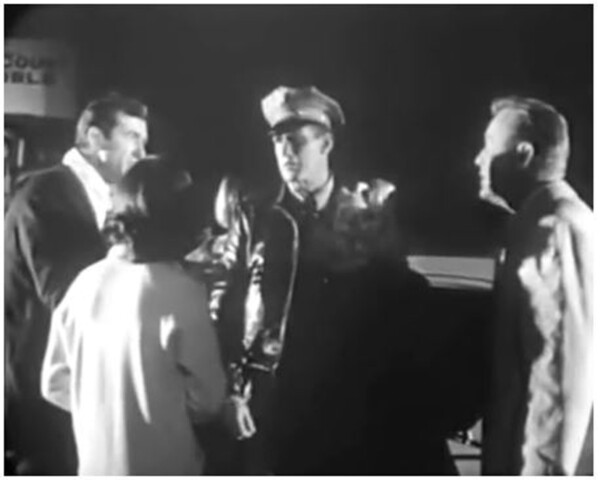Del reviews ‘This Is Not a Test’

Image courtesy of GPA Productions.
“This Is Not a Test” Starring Seamon Glass, Thayer Roberts, Aubrey Martin, Mary Morlas, Michael Greene and others. Directed by Frederic Gadette. 1 hour, 13 minutes. Unrated. Streaming on YouTube, Internet Archive.
Plot synopsis: A sheriff’s deputy sets up a roadblock on a lonely mountain road early one morning after receiving word of a possible nuclear attack. Soon several motorists gather at the checkpoint and must work together to save themselves.
Are there spoilers in this review: No.
Del’s grade: C-
—
Del’s take
The Bulletin of Atomic Scientists has published a Doomsday Clock, a metric to measure the risk of nuclear war, since 1947 when the clock was set to 7 minutes to midnight.
In 2024 that clock was set to 90 seconds to midnight. Given recent events in Ukraine, Gaza and Israel-Iran, 90 seconds is not only prudent but generous. It reminds those of a certain age that while the Cold War may have been waged 60 years ago, history has an odd way of repeating itself when humanity takes its eye off the ball.
A number of movies from that era reflect the national angst over atomic warfare, movies like “On the Beach,” “Fail Safe” and “Doctor Strangelove.” Add to that cinematic paranoia the 1962 film “This Is Not a Test,” a low-budget production that comes nowhere near the quality of a “Fail Safe” or “Doctor Strangelove” but serves one useful purpose, that of cautionary tale. It’s just not the “cautionary” you might expect.

“This Is Not a Test” was filmed in 1962 in Los Angeles County. Because none of the actors are known, they aren’t listed in the credits. No release date was given, but the studio was listed as GPA Productions.
How is the movie cautionary?
Apart from the obvious – that nuclear war is bad – it serves as a reminder to those who would take us back to the “good old days” (Are you listening, MAGAts?) that those times weren’t really all that good. Watching “This Is Not a Test” in 2024 shows us how far we’ve come as a society, and how far we’ll fall if we give in to the forces of ignorance and hate that would turn back the clock, in this case toward a social doomsday.
In “This Is Not a Test” the characters exhibit blind obedience to and trust in authority, embodied by the sheriff’s deputy, who over the course of the film evolves into a cruel autocrat. The motorists, i.e. “voters,” follow his commands without complaint or question, handing over their car keys and unloading a truck to use as a makeshift bomb shelter. I’m hard pressed to say people of today would behave like that given the sizeable number of voters who would entrust their freedoms to a criminal and traitor. But at least some of us have grown as human beings over the years.
Women are treated like property. That was often the case in movies from this period, but in “This Is Not a Test” women operate almost exclusively as instruments of male dominance and facilitators of their own downfall. A wife cheats on her husband with another man and the husband meekly skulks away. One man wins, another man loses, and the woman? She means no more to the story than a knife or a gun, used to achieve those ends.
Booze unloaded from the truck becomes a symbol for disrespect, not only for the deputy’s authority but for human decency itself. Those who consume it are depicted as morally bereft and unworthy of salvation.
And then there’s cruelty to animals, horrifying by today’s standards. In one scene a mentally ill man destroys crates carrying chickens and hurls live birds into the ground. In another scene the deputy chokes a woman’s poodle to death because it’s using up all their oxygen. Animals don’t even figure into the equation of life.
So yeah, the “good old days” weren’t really all that good, and while I understand that when people yearn for the past they’re talking about gas that cost 30 cents a gallon or Momma’s homemade biscuits, they need to remember there were other things about the past that weren’t so great, and maybe what we have today ain’t so bad.
“This Is Not a Test” is not particularly well written or acted, and it doesn’t measure up to those other movies I mentioned. But it’s useful in showing us just how much we’ve grown as a society, and how far we’ll fall if we turn the clock back to the doomsday of the past.
I give it a C-.
Del Stone Jr. is a former journalist and writer.